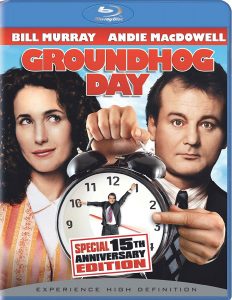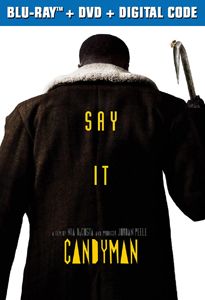I think of “Candyman” (2021) – which I want to call “C4ndyman” since it’s the series’ fourth film, but which I’ll abbreviate as “C4” – as a Jordan Peele film. It’s his third film since he burst onto the horror scene, following the ingenious “Get Out” and the nonsensical “Us.” But he’s merely one of three writers here, and another of the writers, Nia DaCosta, is the director.
Black experience through horror
So I don’t know if this is deeply a Peele film, or if that’s a marketing angle. But it does cap a thematic trilogy of sorts where he explores the black experience via the horror genre.
DaCosta makes a strong major-film debut and cinematographer John Guleserian captures the indoor and outdoor — and old and new, and clean and dirty — beauty of Chicago. If this was the first “Candyman” film, it would be a remarkable filmmaking statement.
(SPOILERS FOLLOW.)
“Candyman” (2021)
Director: Nia DaCosta
Writers: Jordan Peele, Win Rosenfeld, Nia DaCosta
Stars: Yahya Abdul-Mateen II, Teyonah Parris, Nathan Stewart-Jarrett
Since it’s the fourth “Candyman” film, it suffers from the same thing as the other sequels: They retell the original’s story. Granted, the 1992 original is B-horror driven by practical gore effects. This one is classier as it mashes up “Candyman” and “The Fly” into a crisper statement about interactions between poor blacks and white authority figures.
We start with Anthony McCoy (Yahya Abdul-Mateen II) and Brianna Cartwright (Teyonah Parris), who live in a gorgeous gentrified apartment building in Cabrini-Green, a slum in the original entry.
He’s a struggling artist and she’s an assistant curator, so how they can afford such a place I’m not sure. But suffice it to say the couple represents well-to-do blacks who are insulated against police-on-black injustice.
A tale of 2 cities
Parts of those slums still stand nearby, including a lusciously boarded-up single-story apartment complex where every unit is covered with graffiti. You can see the old kitchen appliances in the dim recesses. The setting piques Anthony’s artistic interest, as do his chats with laundromat owner Burke (“Fear the Walking Dead’s” compelling Colman Domingo), an expert in the Candyman legend.
This is good stuff, but “C4” is too often flat and cold, and it’s never scary. I think it’s because Peele and DaCosta don’t stick with the central couple, nor with two others (Brianna’s brother and his boyfriend) who complete their core hangout quartet.

The narrative drifts away from Brianna and Anthony, then drifts back for a conclusive statement about how police have power over poor blacks. It’s a revelation to Brianna because she’s not used to it.
Her solution to her predicament then makes for a powerful final statement about why the Candyman – despite being evil and dangerous – is worshiped (figuratively here, not literally like in part three) by many in the ’hood.
Drifting from the point
In “C4’s” middle, we divert to a gallery owner and schoolkids who stupidly say “Candyman” five times into a mirror. The presentation of his kills is artistic, and new for the saga. He’s like a reverse vampire: You can only see him in the mirror.
DaCosta stages the kills conservatively yet violently. In a memorable shot, a girl peeks under a restroom stall and sees a sheet of blood pour down from the countertop. The killer’s hook hand is reflected in a compact mirror. The audio track indicates the killings.
I don’t want to argue that a movie has to stick with proven structure in order to be great. But I’ve recently watched “Halloween Kills” and “C4,” and they both become less compelling when they drift from their main characters’ arcs into other ideas.
Those other ideas might be good on their own, but our emotional connection to the proceedings gets severed.
Say his name … over and over
“C4,” while an artistic and smart experiment, is less satisfying than the original – even though that has the traditional horror concept of a white woman in the lead (Virginia Madsen, who returns here in the form of a tape-recorded voice).
Still, it became an iconic Black Horror film, partly because of its theme of Chicago violence and partly because there weren’t a lot to choose from. “C4” tries to become a truer Black Horror classic by focusing on the experiential divide between black classes – Peele’s staple. It might succeed as a fresh experience if the viewer is unfamiliar with the previous Peele films and “Candyman” films.
But to me – having recently watched the 1990s trilogy – this is too much like the fourth iteration of the same story.

